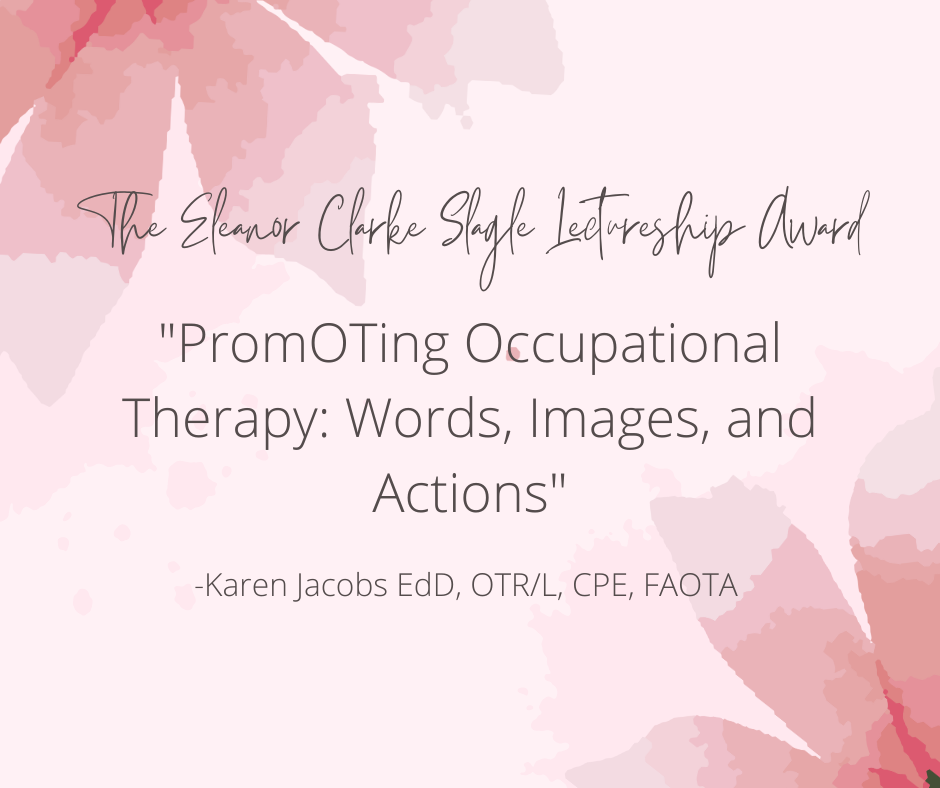A Reflection on the Eleanor Clark Slagle Lecture by Karen Jacobs
A Reflection on the Eleanor Clark Slagle Lecture by Karen Jacobs
Dr. Karen Jacobs, EdD, OTR/L, CPE, FAOTA is an Occupational Therapist and a Clinical Professor who specializes in researching connections between the environment and the human lifestyle. Dr. Jacobs graduated from Boston University in 1979 and received her Master of Science in Occupational Therapy (Boston University, 2023). Dr. Jacobs won the 2011 Eleanor Clark Slagle Lectureship Award from the American Occupational Therapy Association, which is a high honor award in the Occupational Therapy profession dedicated to Eleanor Clarke Slagle, the “mother” of Occupational Therapy. Dr. Jacobs’ Awarding winning lecture, “PromOTing Occupational Therapy: Words, Images, and Actions” stuck out to me for this Nutshell assignment because I have always had an interest in how social media can play such a big role in careers. It is very fascinating to me considering how one of the topics discussed in class is how social media is one of the best ways to raise awareness and spread the word. In our current day society, we look at popular influencers, bloggers, and celebrities and really pay attention to what they post and promote. This can really help capture the attention of all types of audience members. I think that Dr. Jacobs’ writing this lecture in 2012, which was nearly more than ten years ago, and seeing how it is still so relevant today really raises my curiosity on how social media is an important role in just about everything.
2012- the year the world was “supposed” to end, the rise of technology, a whole new era. We saw the shooting of Trayvon Martin, the Sandy Hook Elementary School shooting, Obama’s Re-Election, and so many more vital events that impacted our society and our lives today. Everyone saw these events broadcasted on every news channel, however, the younger generation, really saw it on social media. I was just about 13 years old when I was introduced to social media platforms such as Facebook and Instagram. That same year, Facebook had just bought Instagram, making social media platforms even more dominant and influential in life.
Dr. Jacobs goes in depth within this lecture mentioning the different ways of spreading information about this field and how it has made such an impact, most importantly with marketing, promoting, and word of mouth. Dr. Jacobs does a great job of making sure readers understand the history behind promoting Occupational Therapy, which dated all the way back to the 1920s. Networking was one of the biggest ways to spread the word around that time. Eleanor Clarke Slagle was a huge believer in promoting Occupational Therapy in that sense and it would help each other improve the quality of care for people. As years went by, World War II was another way the profession grew with flyers advertising the need for occupational therapists. Televisions were made, advertisements were on the radio, and Public Service Announcements were announced as well. These tactics are still seen today and continue to be used as a form of marketing. She concluded her lecture by mentioning how we, as practitioners and students, are the ones that are the professionals of promoting Occupational Therapy.
One method that really stuck out to me from this lecture was outbound marketing. Dr. Jacobs explains that outbound marketing is a promotion concept that uses promotional tools such as business cards, advertising, publicity, etc. She explained how business cards are a simple and effective tactic since that is also another way to spread the word. If you simply meet someone and want them to have your information, have a quick and easy definition of Occupational Therapy, one key term, and hand them TWO business cards. This way they have one for themselves, and one they can pass on to another person. Dr. Jacobs mentions the term "client-centered" when it comes to spreading the message about Occupational Therapy. Having a business card with the main key points and relaying the message of showing the audience that Occupational Therapy is more than just therapy, helps the audience know this field is client-centered. This means that occupational therapists look at you as a "whole" and emphasize on what really matters to you. I found this interesting because the method behind this tactic helps not only spread the word about the field and the value of client-centered methods but affects the person getting the card as well as whoever they pass the message onto.
Dr. Jacobs’ lecture on promOTing Occupational Therapy made me realize that applying the tools of marketing, promotion, and communication is an important factor in being a good occupational therapist. It is just as important as keeping up with evidence-based practice. It is our job as occupational therapists (current and future) to utilize our social media platforms and advocate for this profession. Since Dr. Jacobs wrote this lecture back in 2012, we have seen major social media changes and even newer platforms, such as Tik Tok, that can be vital platforms to inform the newer and even older population. Promoting vlogs on YouTube of a “day in your life” segment, answering questions future student applicants might have- all of these segments are ways to help promote the field and help people find out if this field is for them or to inform them that they might need Occupational Therapy. I’m glad Dr. Karen Jacobs gave a spotlight on this subject and help emphasize that social media and marketing can help spread awareness so easily, especially with new trends showing up each and every day.
Jacobs, K. (2012). PromOTing Occupational Therapy: Words, Images, and Actions. American
Journal of Occupational Therapy, 66(6), 652-671.https://doi.org/10.5014/ajot.2012.666001



Comments
Post a Comment